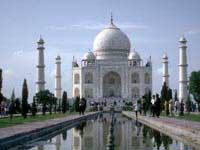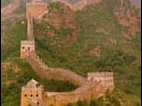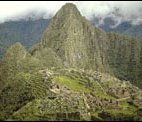Popular buildings

The megalithic passage tomb at Newgrange in Ireland covers over an acre and was constructed around 3200 B.C. Buried for centuries, the mound was rediscovered in 1699 and was restored starting in 1962. The tomb is extensively decorated with spiral and lozenge shapes. At the winter solstice, the rising sun shines down a long passage and lights up a cross-shaped chamber.
The Taj Mahal (1632–1650), at Agra, India, built by Shah Jahan as a tomb for his wife, is considered by some as the most perfect example of the Mogul style and by others as the most beautiful building in the world. Four slim white minarets flank the building, which is topped by a white dome; the entire structure is made of marble.
Another well-known Muslim edifice is the Citadel, located on an outcrop of limestone overlooking Cairo. Begun in 810, it was fortified (1176–1183) by Saladin during the Crusades.
Petra, in Jordan, is an ancient city whose buildings have been carved out of the surrounding hills. It was the capital of the Nabataeans in the 4th century B.C. The most famous of its buildings is Al Khazneh, a temple or treasury, with its impressive two-story facade jutting out from a pink rock.
Other famed Muslim edifices are the Tombs of the Mamelukes (15th century) in Cairo, the Tomb of Humayun in Delhi, the Blue Mosque (1468) at Tabriz, and the Tamerlane Mausoleum at Samarkand.
Angkor Wat, outside the city of Angkor Thom, Cambodia, is one of the most beautiful examples of Cambodian, or Khmer, architecture. The sanctuary was built during the 12th century.
 The 8th-century Borobudur Temple on Java is a masterpiece of Indonesian Buddhist art and architecture. Its ascending terraces feature bas-relief sculptures and 72 Buddha statues.
The 8th-century Borobudur Temple on Java is a masterpiece of Indonesian Buddhist art and architecture. Its ascending terraces feature bas-relief sculptures and 72 Buddha statues.
The Great Wall of China (begun c. 214 B.C.), designed specifically as a defense against nomadic tribes, has large watchtowers that could be called buildings. It was erected by Emperor Ch'in Shih Huang Ti and is 1, 400 mi long. Built mainly of earth and stone, it varies in height between 18 and 30 ft.
The Forbidden City (1407–1420) in Beijing served as the seat of imperial power during the Ming and Qing dynasties (1368–1911). It is the world's largest palace complex, covering about 183 acres and including 9, 999 buildings.
Typical of Chinese architecture are the pagodas, or temple towers. Among some of the better-known pagodas are the Great Pagoda of the Wild Geese at Sian (founded in 652) and Nan t'a (11th century) at Fang Shan.
Other well-known Chinese buildings are the Drum Tower (1273), the Three Great Halls in the Forbidden City (1627), Buddha's Perfume Tower (19th century), the Porcelain Pagoda, and the Summer Palace, all at Beijing.
The painted wooden Torii, or Gateway, at Miyajima Island, Japan, stands in the tidal flats opposite the historic Itsukushima Shrine. Built in the traditional Shinto style, with two columns supporting a concave crosspiece on top, the gate serves to welcome the spirits of the dead as they come from across the Inland Sea.
 Other famous Japanese buildings include Himeji Castle (17th century) and the Buddhist temples of Horyuji (7th century) and Todaiji (8th century) at Nara, and Phoenix Hall (11th century) at Uji near Kyoto.
Other famous Japanese buildings include Himeji Castle (17th century) and the Buddhist temples of Horyuji (7th century) and Todaiji (8th century) at Nara, and Phoenix Hall (11th century) at Uji near Kyoto.
Machu Picchu is an ancient Inca fortress in the Andes Mountains of Peru. Thought to have been built and occupied from the mid-15th century, it is surrounded on three sides by stepped agricultural terraces, which are connected to the main plazas and buildings by thousands of stone steps.
Teotihuacán, located in central Mexico, was the largest city in the Americas at its height between A.D. 300 and 900. Built on a grid plan with a central avenue known as the Street of the Dead, it is the site of two enormous pyramid temples and the temple of the plumed serpent god Quetzalcoatl.
The city of Tikal in Guatemala, with its monumental temples and palaces, embodies the height of the Maya classic period (A.D. 300–900).
Easter Island is famous for its nearly 900 imposing monolithic stone figures called moais that dot the island. The statues are between 10 and 40 ft high and weigh an average of 14 tons. The island's Polynesian inhabitants are thought to have carved the figures between 400 and 1, 000 years ago, but how they accomplished this extraordinary task and what the statues meant to them remains a mystery.
The Chrysler Building (1928–1930) in New York City is one of the finest examples of art deco–style architecture. Built for automotive magnate Walter P. Chrysler, the building uses decorative elements borrowed from automobiles. At 1, 046 ft it was briefly the world's tallest building.
The Empire State Building (1930–1931) is one of the most popular tourist attractions in Manhattan. Features include a tiered structure that recalls ancient pyramids and a mast at the top for mooring dirigibles. Rising to 1, 250 ft (not including the mast), it remained the tallest building in the world until the 1970s.
 The elegant Seagram Building (1954–1958), by Ludwig Mies van der Rohe, soars above an open plaza in Manhattan. Its slim steel frame is covered in amber-gray glass and costly bronze. It has been called the world's most imitated office building.
The elegant Seagram Building (1954–1958), by Ludwig Mies van der Rohe, soars above an open plaza in Manhattan. Its slim steel frame is covered in amber-gray glass and costly bronze. It has been called the world's most imitated office building.
Rockefeller Center, in New York City, extends from 5th Ave. to the Avenue of the Americas between 48th and 52nd Sts. (and halfway to 7th Ave. between 47th and 51st Sts.). It occupies more than 22 acres and has 19 buildings.
The Cathedral of St. John the Divine, in New York City, was begun in 1892 and is now two-thirds completed. When completed, it will be the largest cathedral in the world: 601 ft long, 146 ft wide at the nave, 320 ft wide at the transept. The east end is Romanesque-Byzantine style, and the nave and west end are Gothic.
The Brooklyn Bridge (1869–1883) was the remarkable achievement of engineer John Roebling. The first steel-wire suspension bridge in the world, it has a main span of 1, 596 ft.
The smooth, circular form of the Guggenheim New York Museum (1943–1959), designed by Frank Lloyd Wright, is a Manhattan landmark. The main gallery space features a six-story concrete ramp that spirals up a glass-topped atrium.
The Statue of Liberty was designed by Fredéric Auguste Bartholdi of Alsace as a gift to Americans from the people of France. The statue of a female figure holding a torch in her raised hand was accepted on Oct. 28, 1886, by President Grover Cleveland. The 225-ton steel-reinforced copper structure stands on Liberty Island in New York Harbor. It is 152 ft tall and stands on a 150-foot pedestal.
The Willis Tower, formerly called the Sears Tower, in Chicago is, at 1, 450 ft, the tallest building in the United States. Constructed between 1974 and 1976 for Sears, Roebuck and Company, the structure is composed of 75-foot-square tubes that rise to varying levels.
The Gateway Arch, located on the riverfront in St. Louis, Mo., is a tapered curve of stainless steel rising to 630 ft. The tallest manmade memorial in the United States, the Arch was designed by Finnish-born U.S. architect Eero Saarinen and built between 1963 and 1966. Visitors can ride to the top in specially devised capsule-like tram cars.
Mount Rushmore (6, 000 ft), in South Dakota, became a celebrated American landmark after sculptor Gutzon Borglum took on the project of carving into the side of it the heads of four great presidents. From 1927 until his death in 1941, Borglum worked on chiseling the 60-foot likenesses of Washington, Jefferson, Lincoln, and Theodore Roosevelt. His son, Lincoln, finished the sculpture later that year.












